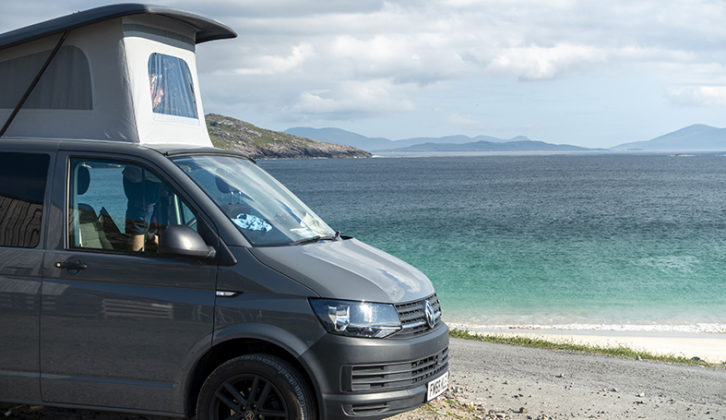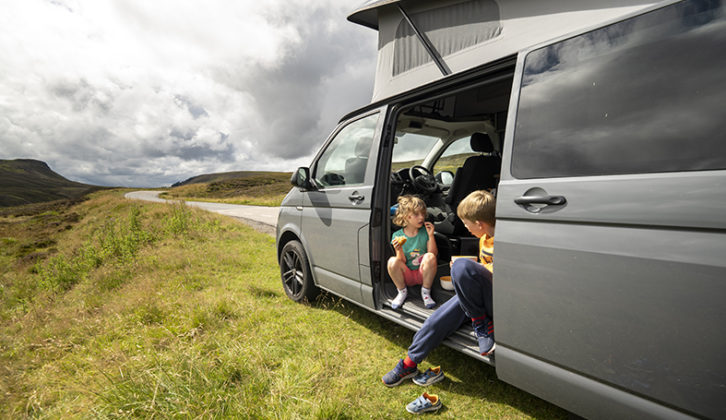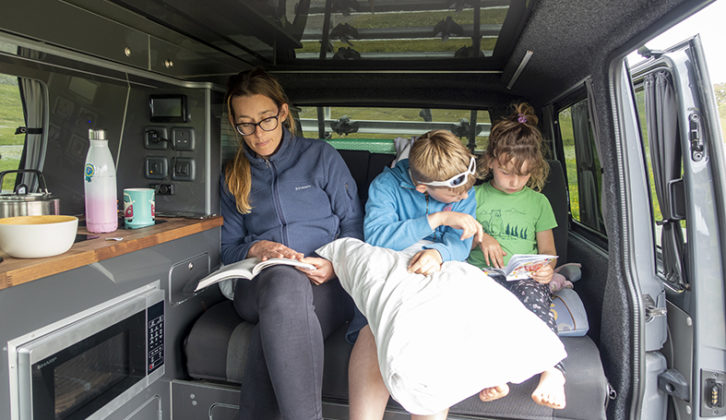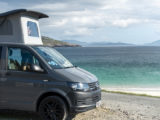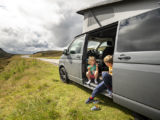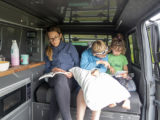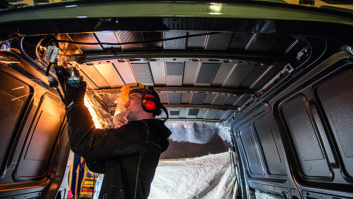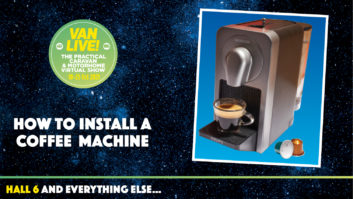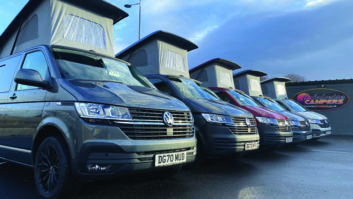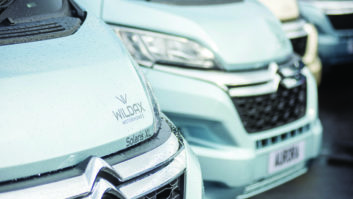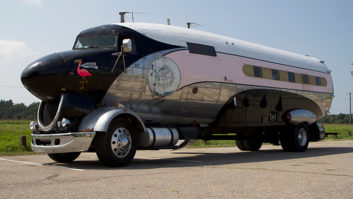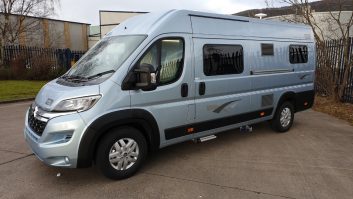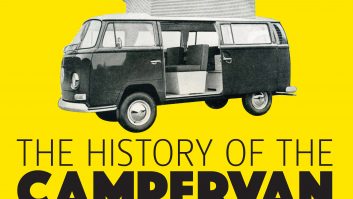Having a long history of camper ownership, Andy McCandlish has bought, converted and driven them for more than 250,000 miles in the past 13 years.
They’ve been his everyday vehicle and workhorse for travelling about the country and now, with two children, they are firmly ingrained in family life.
As his latest vehicle is converted by local Glasgow company Caledonian Campers, Andy shares some of the specialist knowledge built up by himself (and the team at Caledonian) over the years.
Here, Andy completes the story of creating the best campervan for his needs.
With the financial dust finally settling over our conversion, the handover completed by John and the team at Caledonian Campers, and the ‘van finally home and ready for action, there was only one thing left to do. Get out there and use it!
Having come from a 16-year-old T5, there was plenty of coo-ing and button jabbing when the family moved in. USB charging points in the back for the kid’s tablets? Jab. Microwave that we can use anywhere for popcorn? Jab jab. Remote controlled multicoloured strip lights installed up in the pop top roof to make the kids giggle? Click. Giggle. It was like stepping into a Mars lander with cup holders compared to our much loved old ‘van.
We had bought all-new induction-friendly cookware for the new hobs, microwave friendly jugs and plates to maximise our new found oven compatibility, and generally upgraded our kit to suit our new, plush surroundings. It was all brought into play out on the Hebrides, parked up by some of the most glorious beaches that were so beautiful it made your brain throb.
Put the kettle on!
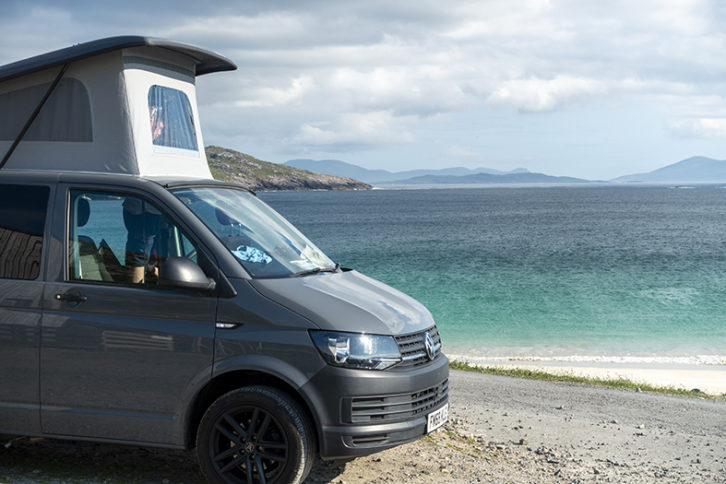
On arrival the kids immediately shot up into their bed in the lifting roof to play (I mean why would you go to the golden, sunny beach 20 yards from the front door?), and we stuck the kettle on – a McCandlish family tradition used to mark our territory when in a new camp spot. This time it was a new experience. With no flame to blow out we could keep the sliding window behind the worktop wide and the side door open, and it still boiled within minutes despite a stiff breeze cooling the inside of the ‘van. Fantastic. One-nil to the induction hobs.
Once the kids were forcibly removed we pushed the bed up on its pneumatic struts, spun the front seats around and revelled in the space. With the beautifully finished walnut worktop, the perfectly engineered cupboards, and tambour doors, it all felt solid and ready to take anything on. We sat back, tea in hand, and felt delighted. I could even feel my red hot bank card cooling with forgiveness as we closed up and went for a wander..
Later on I was itching to deploy the Eberspächer diesel heater, complete with its schedule timer switch, but the family rebelled, pointing to a thermometer that was already showing 25 degrees outside. The very hair on our heads was hot to the touch and dogs panted in the shade across the road, so I relented. Testing would have to wait.
The rest of the weekend was spent enjoying the new ‘van and the beach, and smugly watching the solar panel soak up power without the need for chugging engines. The neat EZA display positioned just above the worktop kept me coming back to see how the new system was faring as the day went on. Multiple kettles were boiled, the fridge chugged away keeping ice creams frozen and a few days food nice and chilled, so there was no shortage of power demand; yet the 130 amp-hour battery was gamely keeping its chin up.
Yes, the biggest question was always going to be this alternative power supply we had chosen. With no gas we were completely reliant on an EZA battery, 2kW pure sine wave inverter and 100W solar panel for all our power and cooking needs. How would this work out? As head amp-miser I carefully watched the display as we went about our daily routines. Boiling a kettle used around 4-5 per cent of the battery, drawing around 50 amps for a few minutes. The microwave used over 100 amps, but was generally only on for a few minutes at a time. Not bad, and over a few days it became apparent that a pretty involved dinner, using both rings for, say, pasta and a lengthy homemade sauce, used around 25 per cent battery all-in, after-dinner coffee and cheeseboard included.
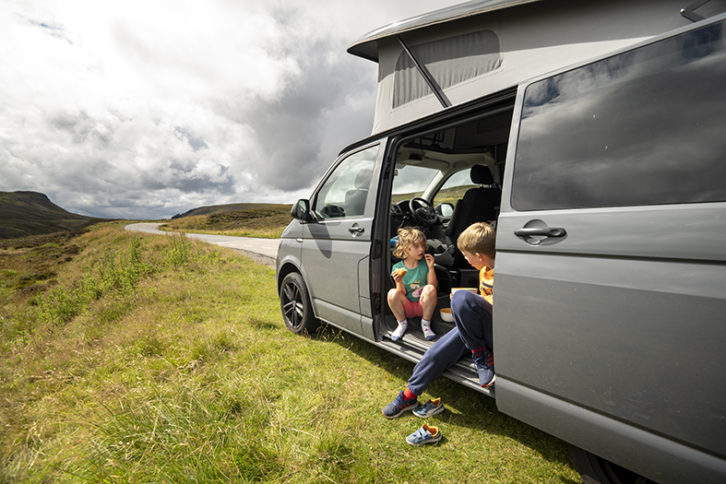
One thing I was quickly aware of was the positioning of the ‘van for the solar panel. Because the roof tilts as it lifts, I got into the habit of positioning that to face south, the general direction of the sun, where practical. The 100 watt solar panel, with a full sun square on, would max out at 7 amps into the battery, but was more usually 5 amps at best, and when the sun went behind the clouds it was more like 1 or 2 amps. In practice this meant you could, at best on a super-sunny day, expect to replace around 20 per cent of the battery when you factor in the semi-constant drain of the fridge. Not bad, but when the clouds came over you really only replaced what the fridge was taking out and didn’t recover any meaningful battery charge.
Of course, as soon as you start driving the battery charges, and we found that to be extremely quick compared to other battery systems. On the road we were firing around 50 amps into the battery when driving, meaning the whole thing could be recharged in around three hours of driving a day. Realistically an hour or two a day should keep you topped up; we never used more than 50 per cent in one day even when using every bell and whistle.
After a subsequent three-day trip at one location on the Moray coast of Scotland with no hook-up and mixed weather (ie not a huge amount of solar input), we managed to get the battery down to 9 per cent, at which point the EZA couldn’t send enough power to run the induction hobs and reset itself. When back online it could happily run the fridge and lights for several more hours, but power hungry items such as the hobs and microwave couldn’t be supported. Three days with no hook- up or engine running didn’t seem bad to me, and at the end of the day we could have just started the engine up to get a boost if needed.
With all that in mind we found that the EZA system we installed would be prefect if you are touring, moving the ‘van each day for an hour or more to recover your battery usage. Of course you can also hook up on site and all these problems go away, but the joy of the EZA battery is the independence from that requirement. Experience now suggests we could easily survive for two days off grid without starting the engine, extending to three or more if the sun is shining and we are careful not to squander precious amps.
Family approval
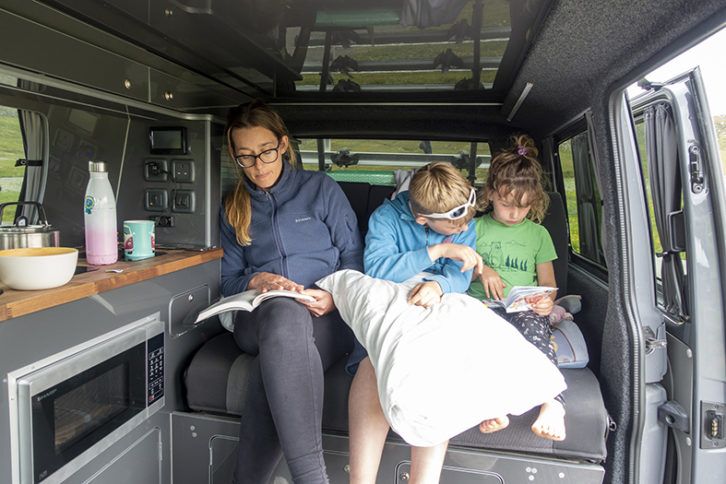
Would I fit it again? Without a doubt. But when recommending it to others I always tell them to make sure it suits the pattern of their camping before making a decision. With the battery versus gas decision validated we carried on to enjoy the rest of the van. The RIB seat was a complete success as suspected, with the excellent space behind it a perfect place to throw our gear when travelling. The kids loved their upstairs domain, using the LED to have a bit of fun, but also to wind down – they found a way to mix the colour to make a sleep – promoting amber glow. Or so they said – it didn’t seem to have a huge effect on them from where I was sitting at 11pm listening to the excited chatter.
We have used campervans for years and dearly loved our old T5. It took our family on a lot of adventures, and the kids even cried when it got sold which broke all our hearts. But sitting on that glorious beach we all agreed this new one will fit neatly into the large shoes it left behind. We are already discussing the next trips. And what about winter now we have that diesel heater?
Looking for some more conversation inspiration? Find out how David and Gillian Rivers got on when they converted a double-decker bus into a mobile farm – and then a holiday let.
If you liked this… READ THESE:
How to choose a base van (Part One)
How to choose a base van (Part Two)
Converting a Campervan (Part One)
If you’ve enjoyed reading this article, why not get the latest news, reviews and features delivered direct to your door or inbox every month. Take advantage of our brilliant Practical Motorhome magazine SUBSCRIBERS’ OFFER and SIGN UP TO OUR NEWSLETTER for regular weekly updates on all things motorhome related.
With the handover completed, and the 'van finally home and ready for action, there was only one thing left to do. Get out there and use it!
